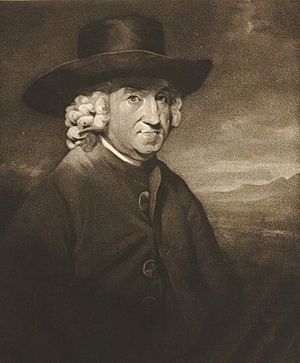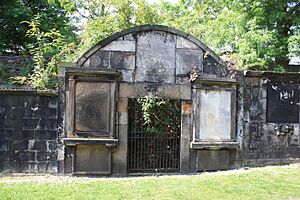William Tytler facts for kids
William Tytler (1711–1792) was a Scottish lawyer who became famous as a writer about history. He wrote a book called An Inquiry into the Evidence against Mary Queen of Scots. In this book, he disagreed with the ideas of another historian, William Robertson. Tytler also found an old handwritten book called the "Kingis Quhair" (which means "King's Work"). This was a poem written by James I of Scotland. In 1783, William Tytler helped start the Royal Society of Edinburgh, a group for smart people interested in science and learning.
Contents
Early Life and Career
William Tytler was born on October 12, 1711. His father, Alexander Tytler, was a lawyer in Edinburgh, Scotland. His mother was Jane Leslie from Aberdeen.
William went to school at Edinburgh high school. Then, he studied law at the University of Edinburgh. He learned to be a lawyer by working with another lawyer, William Forbes. In 1744, he became a "writer to the signet." This was a special type of lawyer in Scotland who prepared important legal documents. After that, he started his own law business in Edinburgh.
William Tytler was very good at his job. He earned enough money to buy a large piece of land called Woodhouselee. This estate was near Roslin, close to the Pentland Hills.
Interests and Hobbies
Besides his law work, William Tytler loved history and old things (archaeology). In 1754, he joined a group called the Select Society. This group was started by the painter Allan Ramsay. Members of the society would meet to discuss different topics.
William Tytler also enjoyed music. He was skilled at playing the harpsichord and the flute. He was one of the first members of the Musical Society of Edinburgh. He once shared his advice for a happy old age: "short but cheerful meals, music, and a good conscience."
Important Writings
William Tytler wrote several important books and papers.
Defending Mary Queen of Scots
His most famous book was The Inquiry, Historical and Critical, into the Evidence against Mary Queen of Scots. It was published in 1759. In this book, Tytler tried to show that Mary Queen of Scots was innocent of the crimes she was accused of. He also looked at the writings of other historians like Dr. Robertson and David Hume.
Tytler's book was very popular. It was printed four times and translated into French twice. Even famous writers like Samuel Johnson and Tobias Smollett reviewed it. He also wrote an extra part about Mary's marriage to Lord Bothwell. This was published in 1792.
Discovering Old Poems
In 1783, Tytler published The Poetical Remains of James I, King of Scotland. He found a very old handwritten book (a manuscript) in the Bodleian Library. In this book, he discovered a poem called the Kingis Quair. Tytler believed that James I of Scotland wrote this poem, and many people today agree with him.
Tytler also thought that James I wrote a funny poem called Christ's Kirk on the Green. However, most experts now believe this poem was written later by someone else.
Other Works
William Tytler also wrote other pieces. He wrote Observations on the Vision, a poem where he said that Allan Ramsay was the true author. He also wrote An Account of the Fashionable Amusements and Entertainments of Edinburgh in the Last Century. This paper described how people in Edinburgh had fun in the 1600s.
Family Life
In 1745, William Tytler married Anne Craig. She passed away in 1783. They had eight children together, but four of them died before William did. Their surviving children were Alexander Fraser Tytler, Colonel Patrick Tytler, and Christina.
His son, Colonel Patrick Tytler, married Isabella Erskine. She was the daughter of James Erskine, Lord Alva, who was one of William Tytler's legal friends.
William Tytler passed away at his home, Woodhouselee, on September 12, 1792. He is buried in the family tomb at Greyfriars Kirkyard in Edinburgh. His son Alexander and grandson Patrick Fraser Tytler are also buried there.



